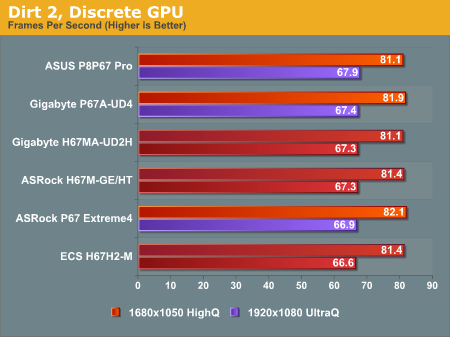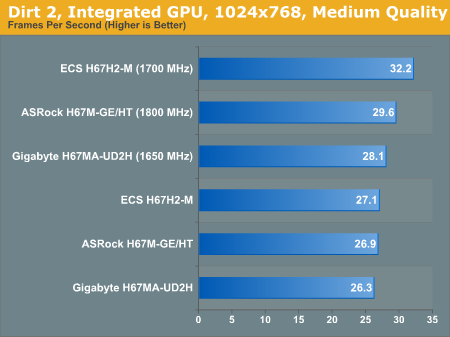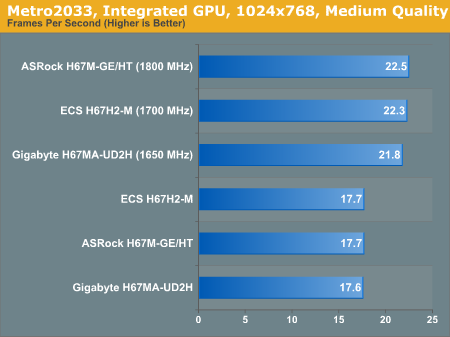H67 – A Triumvirate of Tantalizing Technology
by Ian Cutress on March 27, 2011 6:25 PM EST- Posted in
- Motherboards
- Sandy Bridge
- H67
Dirt 2
Dirt 2 came to the PC in December 2009, developed by Codemasters with the EGO Engine. Resulting in favorable reviews, we use Dirt 2’s inbuilt benchmark under DirectX 11 to test the hardware. We test two different resolutions at two different quality settings using a discrete GPU, and an appropriate integrated GPU setting.


Metro 2033
Metro 2033 is the Crysis of the DirectX 11 world (or at least until Crysis 2 is released), challenging every system that tries to run it at any high-end settings. Developed by 4A Games and released in March 2010, we use the inbuilt DirectX 11 Frontline benchmark to test the hardware.












56 Comments
View All Comments
bigboxes - Monday, March 28, 2011 - link
That's why I always have a spare video card for just such an emergency. Since my motherboards tend to be on the higher end they don't have video out anyways. I wouldn't want the mfg to take away other ports just to include video out. It makes sense on HTPC applications as well as low end or micro-ATX boxes where utility is the priority. I just buy a cheap card that is $30 after rebate and leave it in the box until I need it for troubleshooting or in case of emergency.rustycurse - Monday, March 28, 2011 - link
on page 1:"The same question ultimately applies to the Sandy Bridge chipsets – why only allow CPU overclocking on P67 (and Z68 in the future)? "
I was always thought that term 'Sandy Bridge' is applied to CPU technology and 'Cougar point' to the chipset or am I wrong?
...but about shown mobos ... neither of them suit my tasks. I won't buy it
crispbp04 - Monday, March 28, 2011 - link
"The ECS H67H2-M is a few serious check points against it as a board to use."is or has?
WasabiVengeance - Monday, March 28, 2011 - link
Quick question: How many of those vid outputs can the board actually use simultaneously? Previously intel chipsets were limited to 2.Shadowmaster625 - Monday, March 28, 2011 - link
"However, I remember the time when I was a scrimping student. I wanted high gaming performance at the lowest cost – if Sandy Bridge was out then, and I was specifically after the Sandy Bridge platform over anything AMD, then a H67 with an i3-2100 and the biggest graphics card I could afford would be a viable option."That would be a huge waste of money. Why buy an i3-2100 if you're just going to plug in a gpu anyway? And why buy an H67 when it clearly costs $50 beyond what it should, especially since it has no northbridge.
An ASRock M3A770DE motherboard AND an Athlon X3 cpu together costs the same as one of these H67 scams. Not to mention the $125 for the intel cpu. No way. If I needed more cpu performance I would get the Phenom II X4 965 Black Edition and still have an extra $50 that could go into a better gpu.
DaveSimmons - Monday, March 28, 2011 - link
For budget gaming, H61 seems the better choice by far, with motherboards in the $60-65 range, At that price the price advantage of AMD budget CPUs go away (at stock speed anyway) and the intel HSF is quieter than stock AMD HSF from what I've read.SilentPCReview compared Intel Core i3-2100 vs. AMD Phenom II X2 565 and the intel won on both performance and power use. Spend a bit more for an i5 and you'll have a solid midrange gaming system.at a budget price.
ritchan - Tuesday, March 29, 2011 - link
"With H67 and its no overclocking rule, the market that wants a cheaper board can get that cheaper board."Yet these reviewed boards are still on average more expensive than an AMD board in an equivalent market segment. Which support overclocking and core unlocking. Also, bargain bin motherboards haven't been known for their overclocking prowess, i.e. the power window argument doesn't hold. If you're buying cheap, you get that power window anyway.
Also notice how the cheaper AMD boards like the 870-UD3R or MSI's boards come with absolutely no heatsinks on the VRMs. Bye bye, power window argument.
Stop trying to justify negative market segmentation. The H67/P67 split is a step back from where things were before, and it only gives Intel a good excuse to charge extra for overclocking enabled chipsets in the future. Wait, they're already doing that... and you're sugarcoating it for them.
glad2meetu - Tuesday, March 29, 2011 - link
I think Intel has done a very poor job with the Sandy Bridge release. Intel appears like it is lost in the woods these days and needs a new CEO.I think I would choose a ASUS or a Gigabyte motherboard if I had to pick one for Sandy Bridge. I am surprised how poor the Intel chipsets are. Intel inside no longer means anything special.
strikeback03 - Tuesday, March 29, 2011 - link
The CPUs are special. The rest of the platform, not so much. If Z68 had been included at launch, and all 6 series chipsets had included USB3 and all SATA ports 6Gbps (not just 2) then I would have a different opinion.strikeback03 - Tuesday, March 29, 2011 - link
Is a cooling fan for RAM really necessary on a platform that allows essentially no overclocking and has relatively fixed memory settings?Also, Intel advertising these CPUs as having a certain multiplier in single-threaded mode then not letting the motherboards use that multiplier is a load of bull.